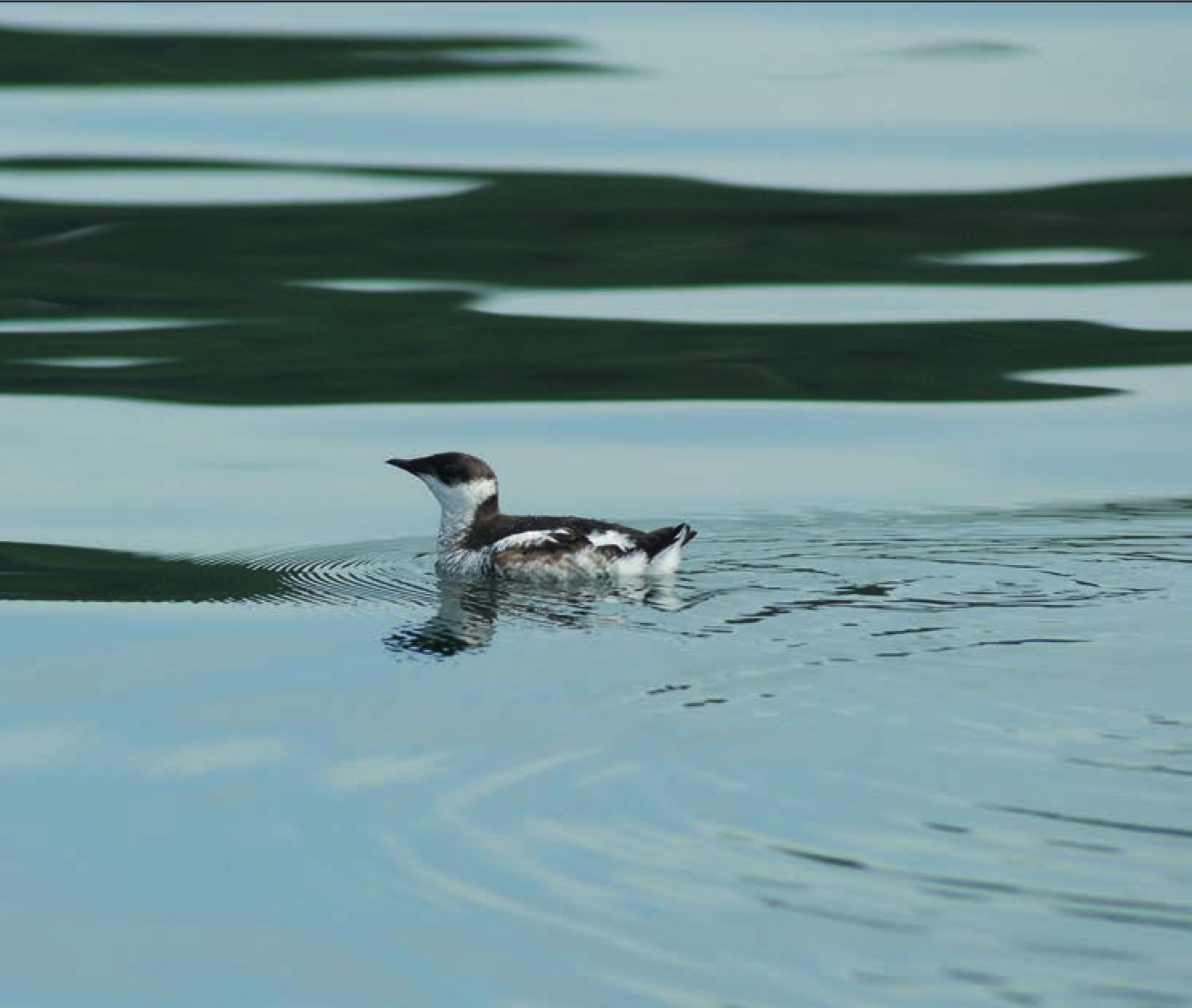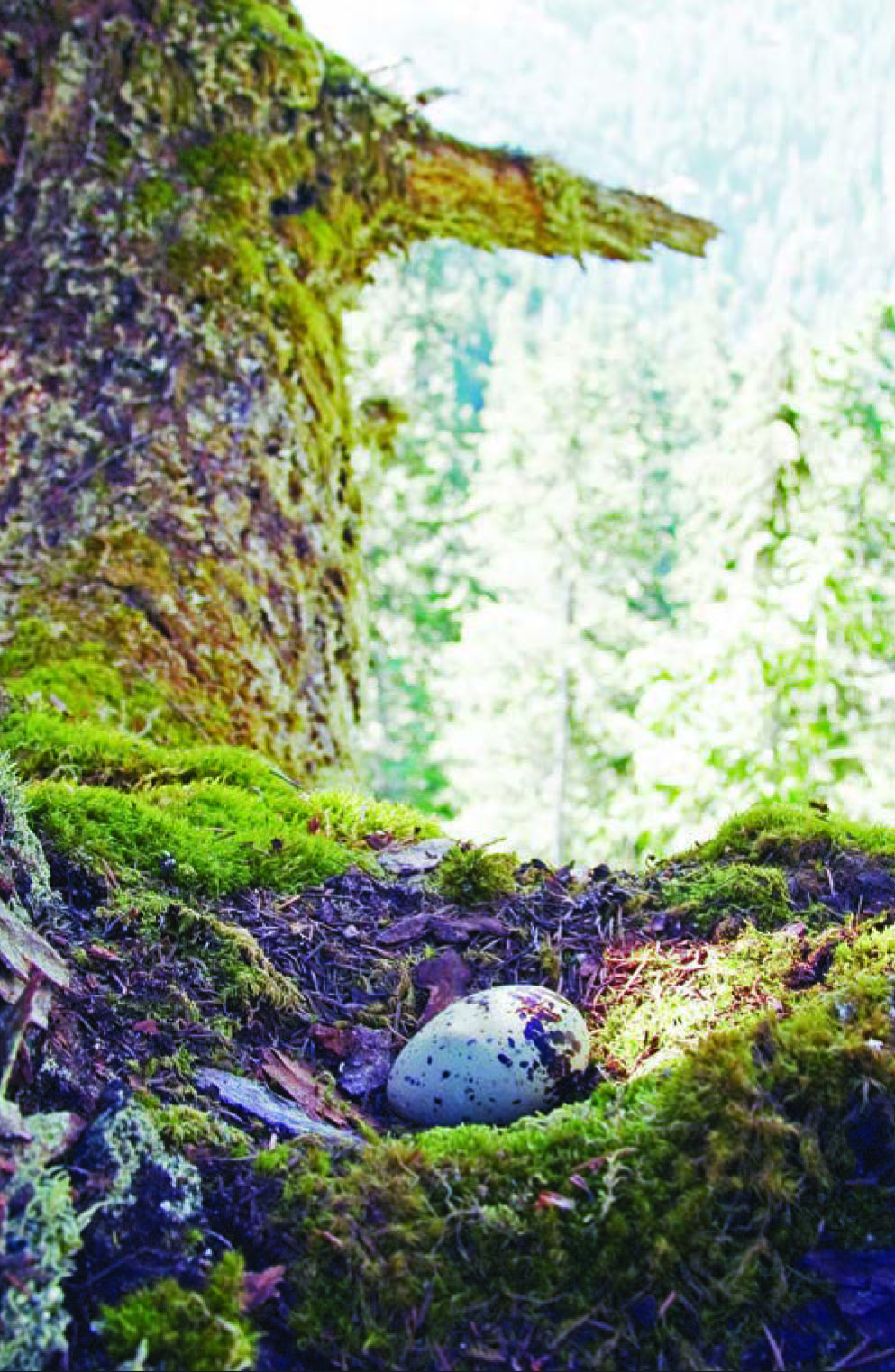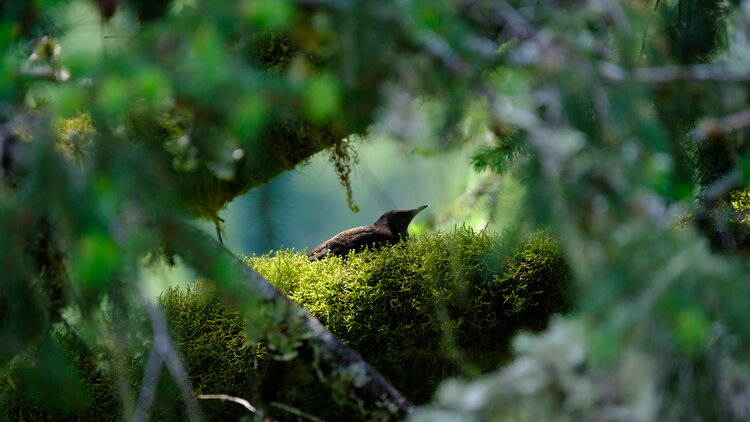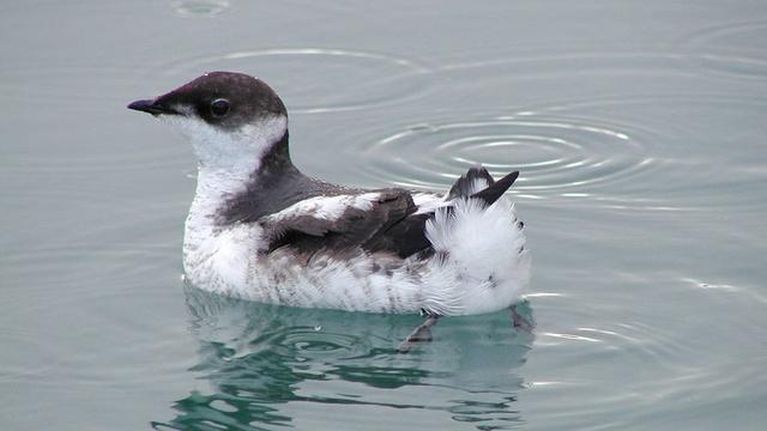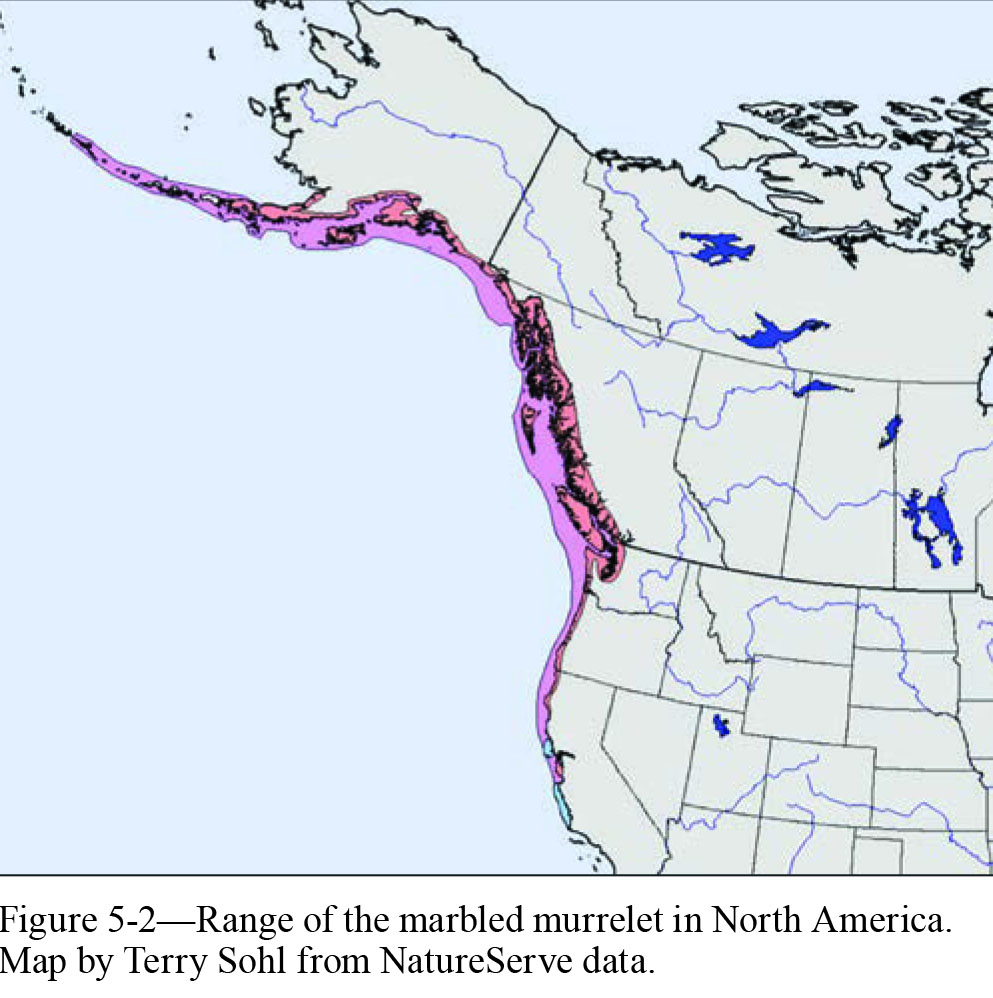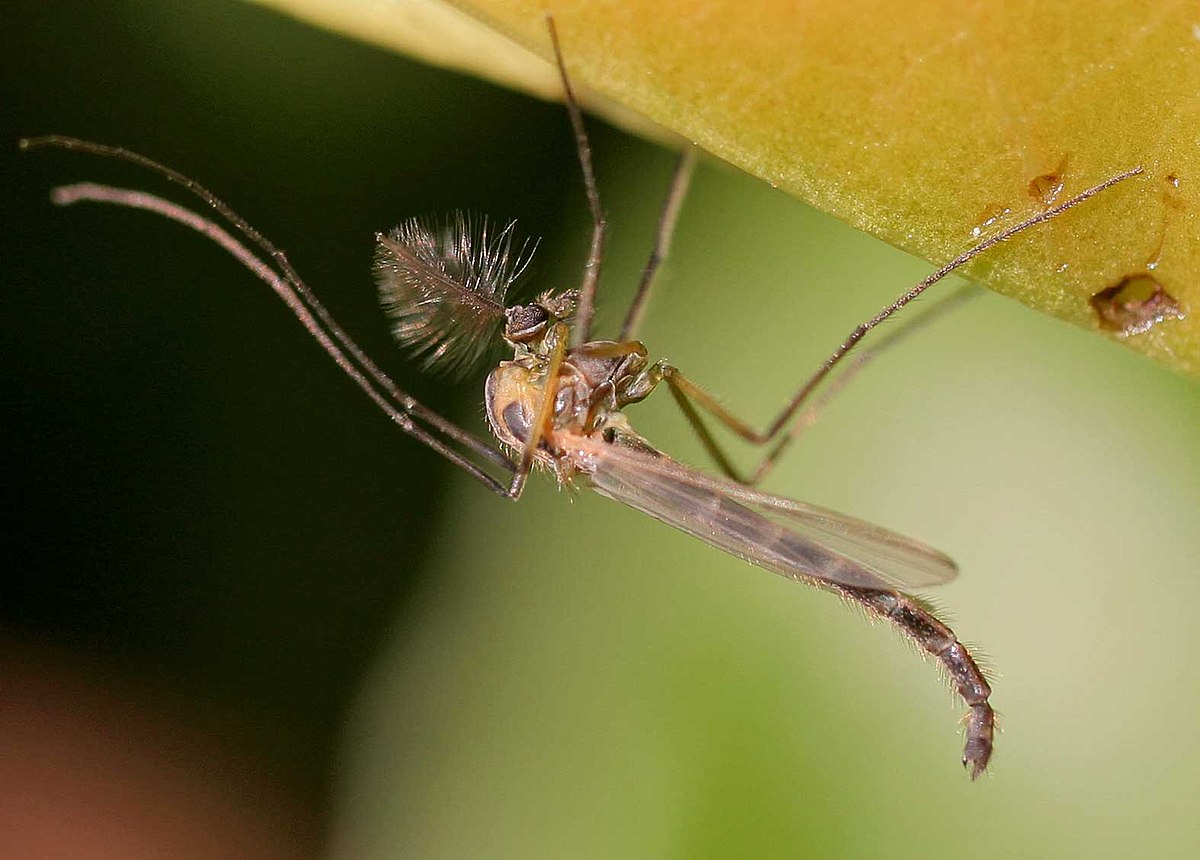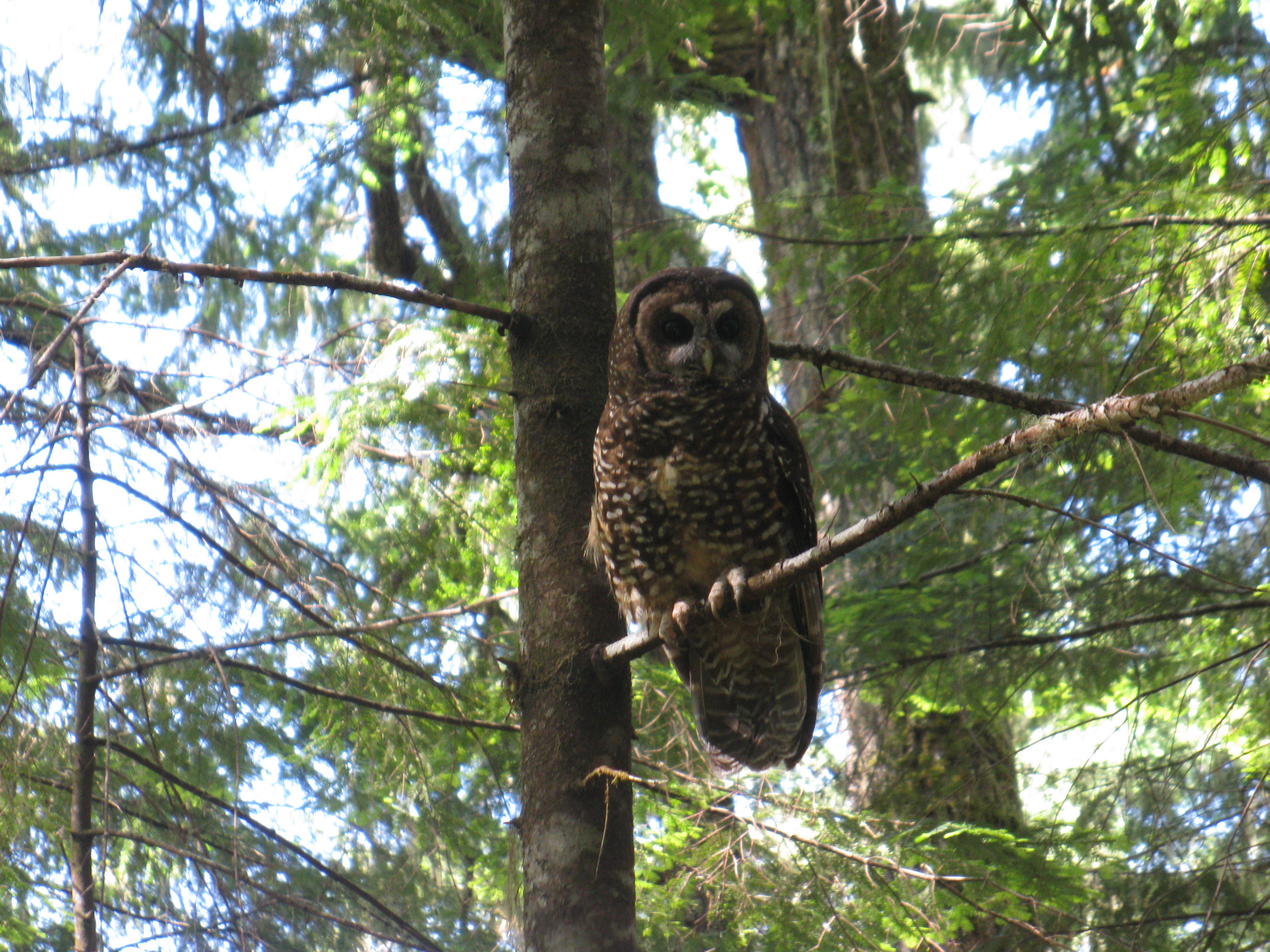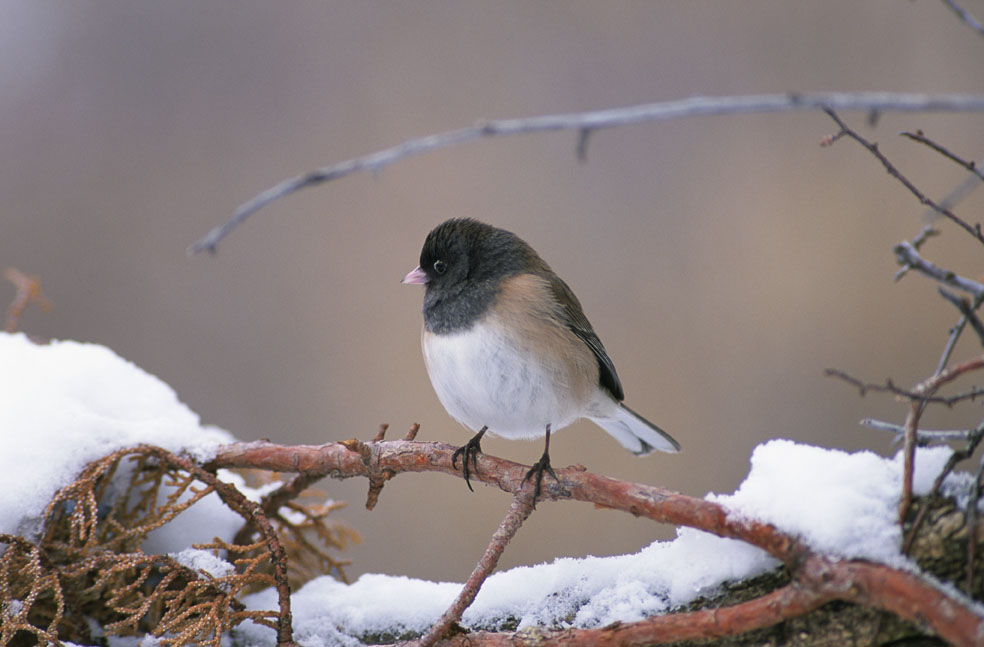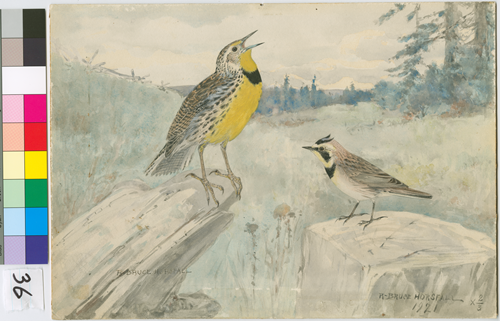The marbled murrelet (Brachyramphus marmoratus) is a unique and cryptic seabird species of older-aged coastal forests and nearshore waters of western Oregon. The health of murrelet populations is intrinsically connected to the health of forests and oceans, and the historic and current degradation of their habitat in Oregon and elsewhere has caused significant declines in their numbers. Climate change is expected to further impact the habitats they depend on. The question is whether murrelets can evolve fast enough to survive the projected changes, given already significant anthropogenic and natural stressors.
Marbled murrelets are small diving seabirds, related to puffins, that forage on schooling fish and invertebrates in the nearshore marine waters of the eastern Pacific, from central California to the Aleutian Islands. They fly as far as fifty miles inland to breed at low densities on the limbs of large trees in coastal coniferous forests, returning to the same site year after year. Murrelets lay a single egg on a moss or other substrate, and both adults participate in incubation, exchanging places every twenty-four hours, and in raising their chick.
The species’ nesting sites—high in trees or on cliffs in rugged terrain in British Columbia and Alaska—are notoriously difficult to locate. While the birds are social on the water and when flying over nesting areas, their plumage is camouflaged when they are breeding, and they conceal their nests deep within the forest canopy. Early ornithologists surmised that murrelets could nest anywhere from offshore rocks to inland forests, but Indigenous people long believed that they nested in the forest, in tree cavities, in burrows in the soil, or under tree roots. Early naturalists likely did not consult Native Americans about their knowledge of this illusive bird.
Marbled murrelets were the last bird species in North America to have their nests found. With the second discovery of a nest in California in 1989 (the first was discovered in 1974) and the first nest in Oregon in 1990, interest in murrelet behavior and habitat increased significantly. There is now evidence that murrelets in Oregon and elsewhere in the Pacific Northwest nest primarily in older-aged coniferous trees in forests that are greater than sixty years in age. They can nest in younger stands that include western hemlock (Tsuga heterophylla) with dwarf mistletoe (Arceuthobium tsugense) infestations, which make branches larger in size. Because murrelets do not build their nests, they need a large limb to lay their single egg.
The best habitat is found in large contiguous stands with multilayered canopies and limited edges (that is, the juxtaposition of open areas, such as a clearcut, next to an older forest) and in areas with low densities of avian and mammalian predators. More than 70 percent of murrelet nests fail each year, primarily due to predation by corvids (ravens and jays) and other predators (for example, owls, hawks, and small mammals).
In Oregon, nests are known to occur up to thirty-two miles inland. Although murrelets have been heard in stands up to forty-seven miles from the coast, nests have yet to be found in those far inland sites. While coniferous (cone-bearing) trees are their preferred nesting habitat, deciduous (leaf-shedding) tree nests were found in 2019 and 2022 in a bigleaf maple (Acer macrophyllum) on the Siuslaw National Forest on the central Oregon Coast. Researchers know of only two other deciduous tree nests to date—one bigleaf maple and one red alder (Alnus rubra)—both in British Columbia.
Most seabird species have evolved a habitat-split strategy, where they nest and forage in areas that are distant from each other. Because seabirds depend on more than one habitat type, especially within a single season, they are believed to be more sensitive to changes in their nesting and foraging habitat. Historical and current losses of older-aged forests, the fragmentation of habitat, high rates of nest predation, and reductions in marine prey have led to significant declines in populations. Because of concerns about their survival, marbled murrelets are listed as both Threatened by the federal government and Endangered by the International Union for Conservation of Nature and the states of Oregon, Washington, and California.
Forested Habitat and Climate Change
Scientists predict that climate change will alter western forests within the range of the murrelet through changing temperatures and precipitation levels, an extension of the fire season, an increase in fire severity and insect outbreaks, and changing tree species composition. While they are uncertain of the exact changes that will occur in the Oregon Coast Range, summer temperatures are expected to increase and summer precipitation is predicted to be much lower, resulting in reduced tree growth, greater tree mortality, and lower moisture levels. Hotter, drier conditions are projected to increase fire risk and intensity, and researchers believe that drier forests will affect the distribution and abundance of epiphytes (mosses and lichens) that murrelets depend on for nesting. All of these changes will contribute to a reduction in the amount and distribution of older-aged forests, creating less suitable habitat and increasing the amount of edge, which could increase predation on murrelet nests.
With complex, multi-layered canopies, old-growth and older-aged contiguous forests can buffer the effects of climate change because they maintain cooler summer temperatures (by as much as 2.5°C, or 3.2°F) compared to plantations and younger forests. Knowing that older forests could help bird species that are declining because of increased temperatures, land managers who provide large blocks of contiguous older habitat will likely help buffer murrelets against many of the predicted and negative changes in the forested landscape. Creating buffers to existing murrelet habitat will also be important for decreasing predation on their nests and minimizing the risk of wildfires.
Climate change is also predicted to alter ocean temperatures and the availability of prey within the murrelets’ range. The Northern California Current, which extends from southern British Columbia to southern California, has changed significantly over the last several decades because of shifts in large-scale oceanographic processes, such as winds and currents. Off the coast of Oregon, for example, extended warming periods occurred between 2013 and 2019, when warm surface temperatures prevented the upwelling of nutrient-rich waters from lower in the water column. This caused changes in the distribution and abundance of forage fish populations, which likely affected the productivity of murrelets and other marine species. These types of anomalous events are projected to increase in frequency and duration as climate change progresses.
Current research in Oregon found that murrelets often forgo nesting and rarely fly inland during poor ocean years. In 2017–2019, few tagged murrelets flew inland to nest, likely precipitated by limited prey in close proximity to nesting sites, and many temporarily moved to areas with better foraging conditions in California. While managing climate change effects in marine waters is more difficult than on land, minimizing greenhouse gases and associated temperature increases may be a way to ameliorate changes to nearshore marine systems.
Murrelets connect the land and the sea when chicks deposit guano at their nest sites, providing a critical source of nitrogen to the forest, similar to salmon carcasses. For a species that is already facing threats from changing ocean conditions and loss and fragmentation of nesting habitat, an increase in climate stressors will only accelerate declines. Concurrent conservation measures will need to be taken in both the forest and ocean to ensure that this important split-habitat strategy species persists into the future.
-
![]()
Marbled Murrelet.
Courtesy U.S. Forest Service -
![]()
Marbled Murrelet egg.
Courtesy U.S. Forest Service -
![]()
Nesting Marbled Murrelet.
Courtesy Oregon Marbled Murrelet Project, Oregon State University -
![]()
Marbled Murrelet.
Courtesy U.S. Fish and Wildlife -
![]()
Range of the marbled murrelet.
Courtesy U.S. Forest Service
Related Entries
-
![Climate Change in Oregon]()
Climate Change in Oregon
Within a few hundred miles in Oregon, you can see snowy volcanoes, parc…
-
![Klamath midge]()
Klamath midge
Upper Klamath Lake's nutrient-rich waters support an array of aquatic a…
-
![Northern Spotted Owl]()
Northern Spotted Owl
Natural History The northern spotted owl (Strix occidentalis caurina),…
-
![Oregon Junco]()
Oregon Junco
A hundred years ago, many birds carried the name of “Oregon,” including…
-
![Western Meadowlark]()
Western Meadowlark
On a fence post in Wheeler County, a sandy brown bird delivers a rich s…
Related Historical Records
Map This on the Oregon History WayFinder
The Oregon History Wayfinder is an interactive map that identifies significant places, people, and events in Oregon history.
Further Reading
Nelson, S. K. "Marbled Murrelet (Brachyramphus marmoratus), version 1.0." In Birds of the World, edited by A. F. Poole and F. B. Gill. Ithaca, NY: Cornell Lab of Ornithology, 2020.

